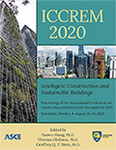International Conference on Construction and Real Estate Management 2020
Optimum Design of Construction Site Layout Based on SLP Method and Genetic Algorithm
Publication: ICCREM 2020: Intelligent Construction and Sustainable Buildings
ABSTRACT
Construction site layout is an important activity in on-site construction, which is to allocate appropriate locations for temporary facilities. A reasonable layout can greatly reduce the material handling cost and construction cycle, at the same time, raise the efficiency and utilization of labour and space. While, site layout planning is a complex multi-objective combination optimization problem. To overcome these problems, this paper proposed an approach for designing and optimizing the temporary facilities layout of construction site. First, systematic layout planning (SLP) method is applied to design the construction site layout based on logistics and non-logistics relationships between temporary facilities. After that, establishes a corresponding mathematical model that includes two objectives of flow intensity and adjacent strength according to the SLP method and uses an improved genetic algorithm to solve the optimization problem. Finally, a case study will be utilized to verify the effectiveness of this method.
Get full access to this article
View all available purchase options and get full access to this chapter.
ACKNOWLEDGEMENTS
This work is financially supported by the Fundamental Research Funds for Central Universities (Project NO.2019CDSKXYJSG0041), the Youth Project of science and technology research program of Chongqing Education Commission of China (Project NO.KJQN201800125), the City Science of Chongqing.
REFERENCES
Benjaoran, V. and Peansupap, V. (2019). “Grid-based construction site layout planning with Particle Swarm Optimisation and Travel Path Distance.” Construction Management and Economics, 1-16.
Domschke, W. and Krispin, G. (1997). “Location and layout planning.” Operations Research Spektrum, 19(3), 181-194.
Easa, S.M. and Hossain, K.M.A. (2008). “New mathematical optimization model for construction site layout.” Journal of Construction Engineering and Management, 134(8), 653-662.
Elbeltagi, E., Hegazy, T. and Eldosouky, A. (2004). “Dynamic layout of construction temporary facilities considering safety.” Journal of Construction Engineering and Management, 130(4), 534-541.
Hammad, A.W.A., Akbarnezhad, A. and Rey, D. (2016). “A multi-objective mixed integer nonlinear programming model for construction site layout planning to minimise noise pollution and transport costs.” Automation in Construction, 61, 73-85.
Hawarneh, A., Bendak, S. and Ghanim, F. (2019). “Dynamic facilities planning model for large scale construction projects.” Automation in Construction, 98, 72-89.
Kumar, S.S. and Cheng, J.C. (2015). “A BIM-based automated site layout planning framework for congested construction sites.” Automation in Construction, 59, 24-37.
Lam, K.C., Ning, X. and Ng, T. (2007). “The application of the ant colony optimization algorithm to the construction site layout planning problem.” Construction Management and Economics, 25(4), 359-374.
Lam, K.C., Tang, C.M. and Lee, W.C. (2005). “Application of the entropy technique and genetic algorithms to construction site layout planning of medium-size projects.” Construction Management and Economics, 23(2), 127-145.
Le, P.L., Dao, T.M. and Chaabane, A. (2019). “BIM-based framework for temporary facility layout planning in construction site: A hybrid approach.” Construction Innovation-England, 19(3), 424-464.
Li, H. and Love, P.E. (1998). “Site-level facilities layout using genetic algorithms.” Journal of Computing in Civil Engineering, 12(4), 227-231.
Li, J., Guo, H., Zhang, S., Wu, X. and Shi, L. (2019). “Optimum design of ship cabin equipment layout based on SLP method and genetic algorithm.” Mathematical Problems in Engineering, 9492583.
Lin, Q.L., Liu, H.C., Wang, D.J. and Liu, L. (2015). “Integrating systematic layout planning with fuzzy constraint theory to design and optimize the facility layout for operating theatre in hospitals.” Journal of Intelligent Manufacturing, 26(1), 87-95.
Ning, X., Lam, K.C. and Lam, M.C.K. (2010). “Dynamic construction site layout planning using max-min ant system.” Automation in Construction, 19(1), 55-65.
Osman, H.M., Georgy, M.E. and Ibrahim, M.E. (2003). “A hybrid CAD-based construction site layout planning system using genetic algorithms.” Automation in Construction, 12(6), 749-764.
Papadaki, I.N. and Chassiakos, A.P. (2016). “Multi-objective construction site layout planning using genetic algorithms.” Procedia Engineering, 164, 20-27.
Tate, D.M. and Smith, A.E. (1995). “Unequal-area facility layout by genetic search.” IIE transactions, 27(4), 465-472.
Yahya, M. and Saka, M.P. (2014). “Construction site layout planning using multi-objective artificial bee colony algorithm with Levy flights.” Automation in construction, 38, 14-29.
Yeh, I.C. (1995). “Construction-site layout using annealed neural network.” Journal of Computing in Civil Engineering, 9(3), 201-208.
Yi, W., Chi, H.L. and Wang, S. (2018). “Mathematical programming models for construction site layout problems.” Automation in Construction, 85, 241-248.
Zhang, H. and Wang, J.Y. (2008). “Particle swarm optimization for construction site unequal-area layout.” Journal of Construction Engineering and Management, 134(9), 739-748.
Zhou, F., AbouRizk, S.M. and Al-Battaineh, H. (2009). “Optimisation of construction site layout using a hybrid simulation-based system.” Simulation Modelling Practice and Theory, 17(2), 348-363.
Information & Authors
Information
Published In
ICCREM 2020: Intelligent Construction and Sustainable Buildings
Pages: 71 - 83
Editors: Yaowu Wang, Ph.D., Harbin Institute of Technology, Thomas Olofsson, Ph.D., Luleå University of Technology, and Geoffrey Q. P. Shen, Ph.D., Hong Kong Polytechnic University
ISBN (Online): 978-0-7844-8323-7
Copyright
© 2020 American Society of Civil Engineers.
History
Published online: Oct 14, 2020
Published in print: Oct 14, 2020
Authors
Metrics & Citations
Metrics
Citations
Download citation
If you have the appropriate software installed, you can download article citation data to the citation manager of your choice. Simply select your manager software from the list below and click Download.
